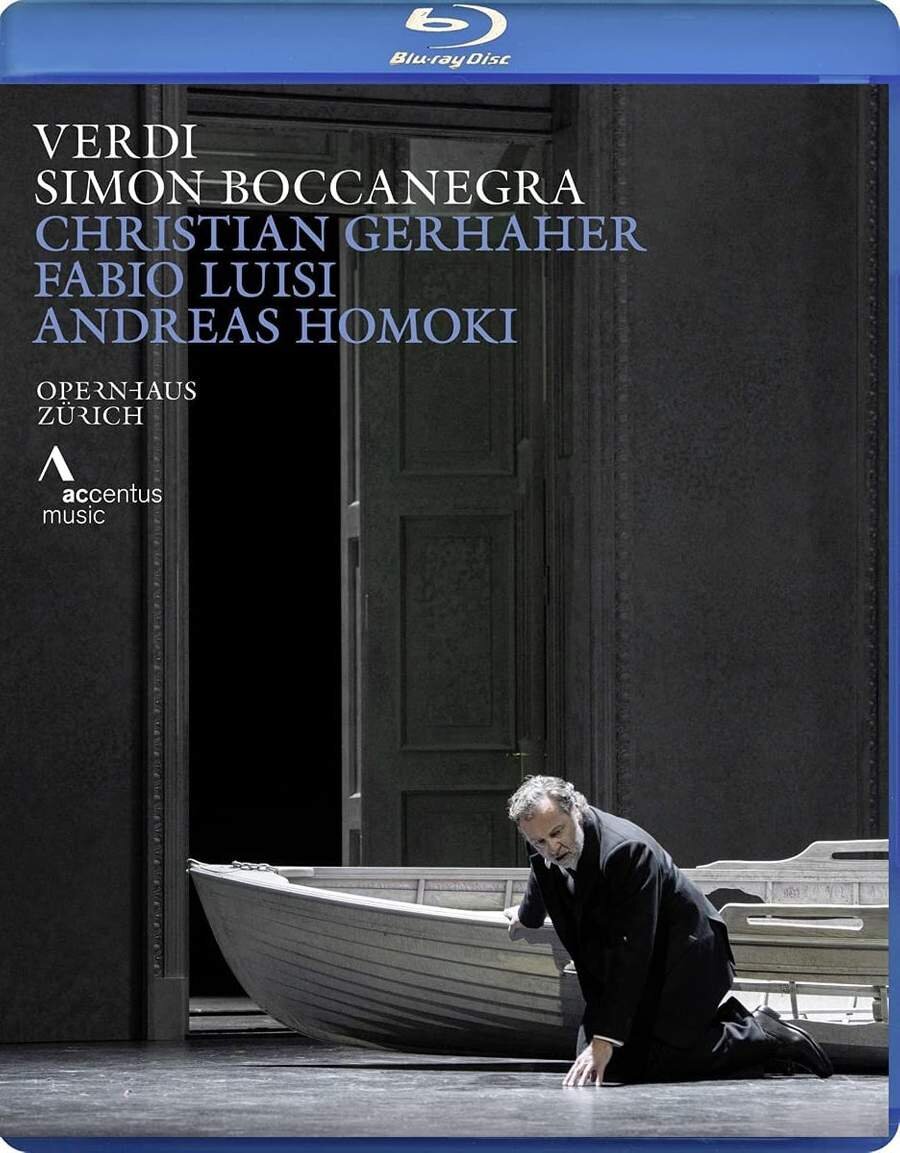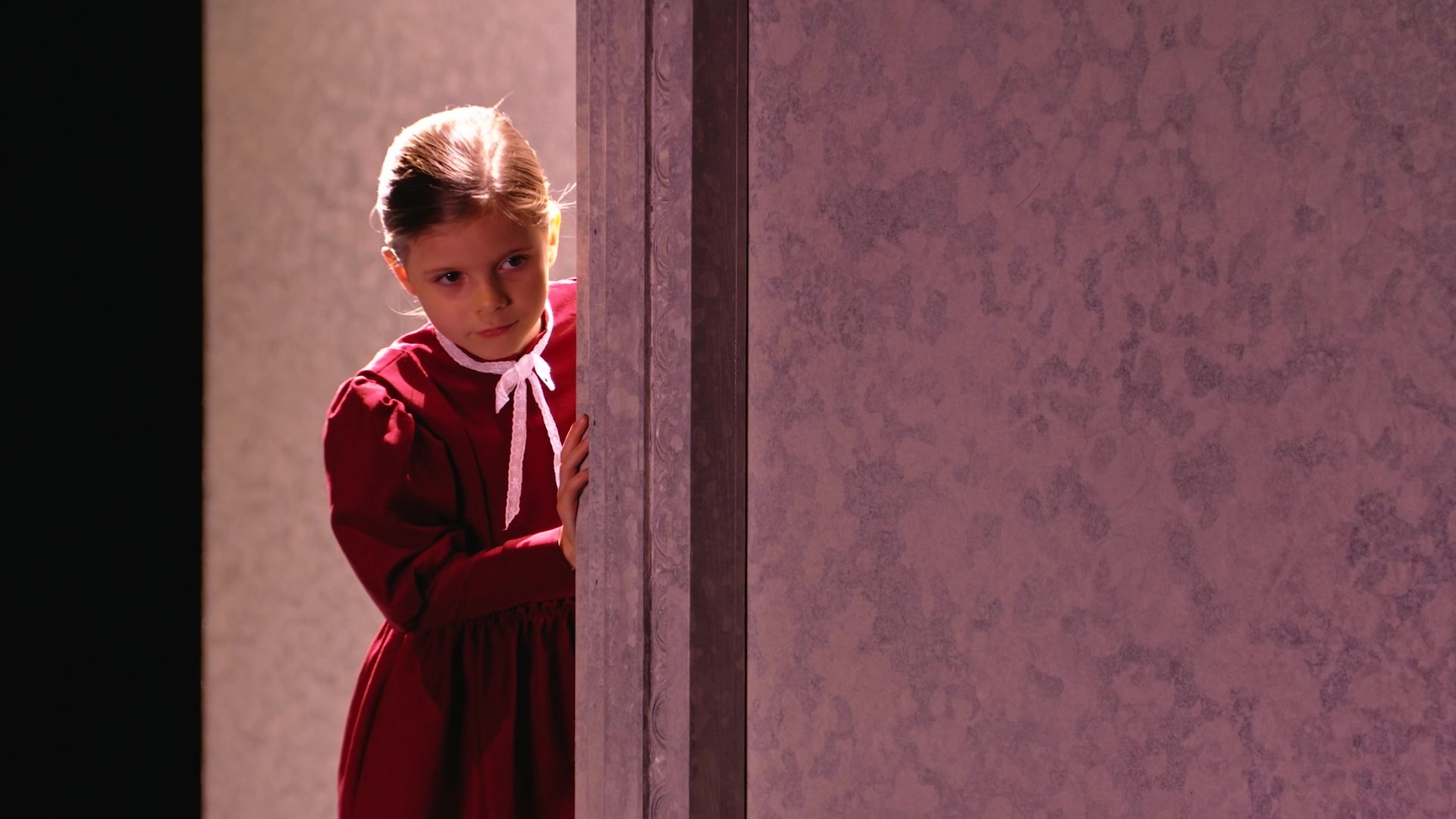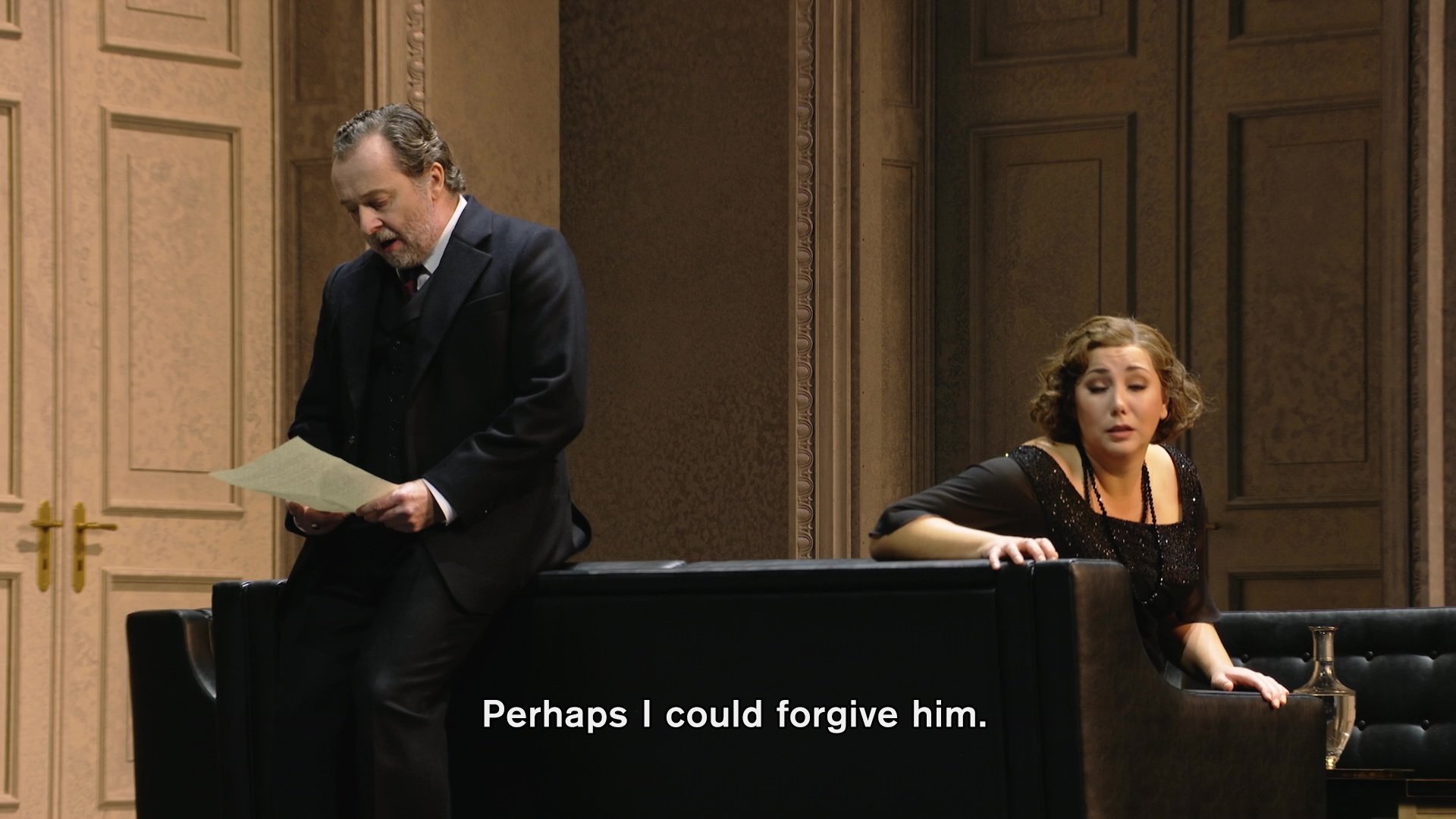

Verdi Simon Boccanegra opera to a libretto by Francesco Maria Piave and later revised by Arrigo Boito. Directed 2020 by Andreas Homoki at the Opernhaus Zürich. Stars Christian Gerhaher (Simon Boccanegra), Jennifer Rowley (Amelia Grimaldi), Christof Fischesser (Jacopo Fiesco), Otar Jorjikia (Gabriele Adorno), Nicholas Brownlee (Paolo Albiani), Brent Michael Smith (Pietro), Siena Licht Miller (Amelia’s Maid), and Savelii Andreev (Captain). Fabio Luisi conducts the Philharmonia Zürich, the Chor der Oper Zürich, and the Statistenverein am Opernhaus Zürich. Set and costume design by Christian Schmidt; lighting design by Frank Evin; dramaturgy by Fabio Dietsche. Directed for TV by Michael Beyer; produced by Paul Smaczny. Sung in Italian. Released 2020, disc has dts-HD Master Audio sound. Grade: A+
If you are not a Verdi expert, you may find this opera hard to follow. For help, see my synopsis at the end of this review. You have to be sharp to follow the plot (even with help). I hope my screenshots will help you learn who is who.
We begin with Christian Gerhaher as Boccanegra. He is leader of the Genoese Boccanegra family. He is a plebeian. In 1339 the historical Simon Boccanegra was elected Doge of Genoa; after further political strife, he was poisoned at a banquet:
Our villain is Nicolas Brownlee as Paolo, another plebeian. He helps Boccanegra rise to power, but he later betrays his boss (because of disappointment over loss of a woman):
Next below is Christof Fischesser as Jacopo Fiesco. A leading patrician, Jacopo is Boccanegra’s nemises:
The corpse below is Fiesco’s daughter Maria. She had a daughter out of wedlock fathered by Boccanegra:
A mute role is the unnamed daughter of Maria and Boccanegra as a child:
Next we have Jennifer Rowley as the adult daughter of Maria and Boccanegra. She doesn’t know who she really is because she was brought up in an orphanage. She was adopted by the partrician Grimaldi family and given the name Amelia:
Boccanegra and Amelia discover that they are father and daughter:
Next below meet Otar Jorjikia as Gabriele Adorno. He is a patrician. He is in love with Amelia:
A better view of Adorno. This is the most important line in the libretto. Eventually he will be richly rewarded for his purity of spirit:
Another image of villain Paolo. Unfortunately, he is also in love with Amelia:
Boccanegra as statesman:
Boccanegra as loving spirit:
The end is near:
Made during the Time of Covid, the singers worked in an empty theater while the chorus and orchestra performed 1km away in a rehearsal room! Said by Verdi himself to be a “sad and desolate” work, the staging is appropriately gray. John Rhodes, writing for seenandheard-international.com in August 2020, found Homoki’s show to be “rather dull and gloomy, in keeping with the tone of the opera.” But Rhodes does laud all the singers, especially Gerhaher saying that “His expressions of torment and grief were visible and palpable.” Hugo Shirley digs deeper in the October 2021 Gramophone (pages 96-97). The director moved the story to the time of automatic pistols. Per Hugo, Homoki stresses “imaginary realms of memory and longing rather than the plot” and “the practical restrictions are movingly transmuted into psychological inability.” He praises all the artists (especially Gerhaher and Luisi) and calls this a “highly recommended, distinguished release.”
This is the first production of Simon Boccanegra that I have been able to sit through for the several times it takes to absorb the work. Director Homoki takes us away from the traditional Boccanegra costume melodrama. In an almost abstract setting, he asks us to focus on Verdi’s themes of love of neighbors, justice for all, reconciliation of differences, integrity, and unity. The revolving stage seems to never stop turning just as our lives and the earth itself are never still. Emotions are portrayed through ethereal personal directing and acting in which real events, dreams, and memories are made vivid even though the protagonists rarely touch each other.
PQ and SQ are fine And Michael Beyer does a splendid job of capturing all this in his video file which looks good throughout in high definition Blu-ray. Congratulations to all for this admirable ensemble effort produced under harrowing pandemic conditions. A+
Don’t forget the synopsis below. Here’s the official trailer:
Homoki's Simon Boccanegra Story
Simon Boccanegra surely has one of the trickiest librettos in opera. It has 5 lead roles for men who tend to look and sound alike (mostly baritones and basses). As to females, there is only 1 lead singing role plus minor mute roles as young females and corpses. The plot covers decades. Many plot elements are revealed only through brief passages in the text or must be figured out by an astute observer. The Accentus Music keepcase booklet does not have a synopsis. So if you are not already a Simon Boccanegra expert, this synopsis may help you get up to speed.
Prologue
It's the 14th century when Italians were divided into patricians (rich) and plebeians (not so rich). Each city state in Italy is in often at war with other city states. We are in Genoa, which is at war with Venice.
Boccanegra, a heroic naval mercenary (pirate) for Genoa, is a plebeian. In the past, he had a love affair with Maria, the daughter of Jacopo Fiesco, a patrician. Maria had a girl out of wedlock. Furious that Maria had an affair with a plebeian, Fiesco imprisoned Maria in his palace. But Boccanegra got possession of the baby and sent her to live with an old woman in a village on the coast. Boccanegra visited his daughter from time to time from shipboard. In his last visit, the woman had died and his daughter had disappeared.
Boccanegra continues to love the imprisoned Maria. It came time to elect a new Doge, the ruler of Genoa. Paolo, a goldsmith, proposes that Boccanegra should be elected Doge. Boccanegra is persuaded to serve when Paolo points out that Boccanegra would be able to marry Maria if he becomes the Doge. Paolo goes off with Pietro, a plebeian politician, to drum up support for Boccanegra in the election. Fiesco appears, mourning the fact that Maria has just died. Fiesco encounters Boccanegra but does not tell him that Maria is dead. Boccanegra offers to reconcile. But Fiesco says this will only be possible if Boccanegra gives up the baby girl. Boccanegra explains to Fiesco that he can't produce her because she is lost.
The encounter between Boccanegra and Fiesco is over. Boccanegra sees that the door to the Fiesco palace is open and unguarded. He wanders in and discovers the body of the deceased Maria. In grief he asks for a tomb. At the same time a crowd appears celebrating his new throne. Boccanegra is now ruler of Genoa. But his love and daughter are gone. And Fiesco is his implacable enemy.
[Interlude—-not part of the libretto!]
[25 years passes before Act 1 begins. Boccanegra remains the Doge. He tries to create a stable and just state as a plebeian. He exiles Fiesco and other patricians and confiscates their property. But Fiesco is clever. He returns to Genoa and resides with the patrician Grimaldi family in their palace under the name of Andrea Grimaldi. It just happens that the Grimaldi family has no heirs (their sons having been exiled). So to have an heir, the Grimaldis adopt a girl of unknown parentage being sheltered in a convent. They give her the name Amelia Grimaldi. But, unknown to anyone, Amelia is in fact the lost daughter of Boccanegra and the lost granddaughter of Fiesco. Eventually Fiesco, still under the name of Andrea Grimaldi, becomes Amelia's guardian. This makes Fiesco unknowingly the guardian of his own granddaughter.
The convoluted plot thickens. Amelia, now eligible for marriage, is in love with Gabriele Adorno, a patrician unrelated to the other patricians already mentioned. But Amelia is aware that Paolo, who helped Boccanegra get elected Doge, is now a favorite of the Boccanegra. Paolo is in love with Amelia, and he is threatening to ask for her hand in marriage.]
Act 1
The lovers Amelia and Adorno are together. Amelia warns Adrorno against getting involved in patrician plots against Boccanegra. She also asks Adorno to seek permission immediately from Andrea Grimaldi (as guardian) to marry. This would then negate the imminent danger that Paolo might seek her hand.
Adorno asks Andrea Grimaldi (really Fiesco) for permission to marry Amelia. Andrea reveals that Amelia was a foundling and is not of patrician birth. Adorno wins points by saying he doesn't care—he loves his orphan girl!
As feared, Boccanegra now enters. He softens up Amelia by pardoning two of her brothers. But before he can get around to the subject of marriage to Paolo, Amelia says she is in love with Adorno. This leads to a longer conversation in which Boccanegra and Amelia discover (via portraits each has) that they are in fact father and daughter!
After the discovery scene, Paolo arrives to ask about his proposal of marriage and is informed that he will not be allowed to marry Amelia. Paolo is enraged. He orders his men to abduct Amelia.
Next comes the famous council chamber scene. Boccanegra wants to encourage his councilors to make peace with Venice. Suddenly a mob enters the room. Adorno has killed Lorenzino, a plebeian, who abducted Amelia. It's unclear to Boccanegra who gave the abduction order to Lorenzino. Boccanegra orders the arrest of Adorno. But Boccanegra suspects that Paolo instigated the abduction. He puts Paolo in charge of the investigation of who kidnapped Amelia. He then forces Paolo to put a curse on the perpetrator. You know, of course, that Verdi took curses seriously. So now Paolo has put a curse on himself!
Act 2
Paolo wants revenge. He puts a slow-acting poison in Boccanegra's water. Paolo then tries and fails to trick Fiesco, and later Adorno, into killing Boccanegra. Yet more confusion arises as Paolo works to stir up a revolution of the patricians against Boccanegra. After grand melodramatic twists and turns, Adorno (who was supporting the patricians) pledges support for the Doge. Boccanegra promises Amelia to Adorno if Boccanegra survives Paolo's revolt.
Act 3
Paolo's revolt is defeated, and Paolo is executed. Boccanegra tells Fiesco that Amelia is his granddaughter. This was the price Fiesco demanded for reconciliation with Boccanegra. Adorno and Amelia are married. So now all are reconciled before Boccanegra's death from Paolo's poison. Boccanegra's last words are instructions to name Adorno as the next Doge. Thus Boccanegra hopes to encourage peace between the two social classes as well as between Genoa and Venice. This was in line with Verdi's personal efforts to support the Italian Risorgimento (the unification of Italy into today's modern nation).
OR













